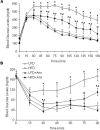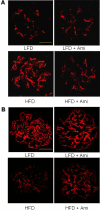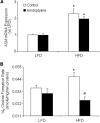Role of sphingolipid mediator ceramide in obesity and renal injury in mice fed a high-fat diet
- PMID: 20543095
- PMCID: PMC2939660
- DOI: 10.1124/jpet.110.168815
Role of sphingolipid mediator ceramide in obesity and renal injury in mice fed a high-fat diet
Abstract
The present study tested a hypothesis that excess accumulation of sphingolipid, ceramide, its metabolites, or a combination contributes to the development of obesity and associated kidney damage. Liquid chromatography/mass spectrometry analysis demonstrated that C57BL/6J mice on the high-fat diet (HFD) had significantly increased plasma total ceramide levels compared with animals fed a low-fat diet (LFD). Treatment of mice with the acid sphingomyelinase (ASMase) inhibitor amitriptyline significantly attenuated the HFD-induced plasma ceramide levels. Corresponding to increase in plasma ceramide, the HFD significantly increased the body weight gain, plasma leptin concentration, urinary total protein and albumin excretion, glomerular damage index, and adipose tissue ASMase activity compared with the LFD-fed mice. These HFD-induced changes were also significantly attenuated by treatment of mice with amitriptyline. In addition, the decline of plasma glucose concentration after an intraperitoneal injection of insulin (0.15 U/kg b.wt.) was more sustained in mice on the HFD with amitriptyline than on the HFD alone. Intraperitoneal injection of glucose (3 g/kg b.wt.) resulted in a slow increase followed by a rapid decrease in the plasma glucose concentration in LFD and HFD plus amitriptyline-treated mice, but such blood glucose response was not observed in HFD-fed mice. Immunofluorescence analysis demonstrated a decrease in the podocin and an increase in the desmin in the glomeruli of HFD-fed mice compared with the LFD and HFD plus amitriptyline-treated mice. In conclusion, our results reveal a pivotal role for ceramide biosynthesis in obesity, metabolic syndrome, and associated kidney damage.
Figures







References
-
- Augé N, Maupas-Schwalm F, Elbaz M, Thiers JC, Waysbort A, Itohara S, Krell HW, Salvayre R, Nègre-Salvayre A. (2004) Role for matrix metalloproteinase-2 in oxidized low-density lipoprotein-induced activation of the sphingomyelin/ceramide pathway and smooth muscle cell proliferation. Circulation 110:571–578 - PubMed
-
- Augé N, Nègre-Salvayre A, Salvayre R, Levade T. (2000) Sphingomyelin metabolites in vascular cell signaling and atherogenesis. Prog Lipid Res 39:207–229 - PubMed
-
- Bradford MM. (1976) A rapid and sensitive method for the quantitation of microgram quantities of protein utilizing the principle of protein-dye binding. Anal Biochem 72:248–254 - PubMed
-
- Brand V, Koka S, Lang C, Jendrossek V, Huber SM, Gulbins E, Lang F. (2008) Influence of amitriptyline on eryptosis, parasitemia and survival of Plasmodium berghei-infected mice. Cell Physiol Biochem 22:405–412 - PubMed
-
- Chavez JA, Knotts TA, Wang LP, Li G, Dobrowsky RT, Florant GL, Summers SA. (2003) A role for ceramide, but not diacylglycerol, in the antagonism of insulin signal transduction by saturated fatty acids. J Biol Chem 278:10297–10303 - PubMed
Publication types
MeSH terms
Substances
Grants and funding
LinkOut - more resources
Full Text Sources
Medical

